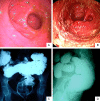Pouchitis: insight into the pathogenesis and clinical aspects
- PMID: 35958439
- PMCID: PMC9360866
Pouchitis: insight into the pathogenesis and clinical aspects
Abstract
Ulcerative colitis (UC) is a chronic intestinal inflammatory disease and familial adenomatous polyposis (FAP) is an autosomal dominant inherited disease. Both diseases, despite being different, may require the same surgical procedure: proctocolectomy with ileal pouch-anal anastomosis (IPAA). The main complication after this procedure is pouch inflammation (pouchitis). This inflammatory complication can affect up to 60 percent of patients who receive IPAA for UC, and a very small percentage of the FAP patients. The purpose of this review was to determine the current molecular mechanisms in its pathogenesis and detail the risk factors involved in pouchitis, its diagnosis, and treatment.
Keywords: Ulcerative colitis; familial adenomatous polyposis; ileal pouch-anal anastomosis; pouchitis.
AJTR Copyright © 2022.
Conflict of interest statement
None.
Figures


Similar articles
-
Pouchitis Is a Common Complication in Patients With Familial Adenomatous Polyposis Following Ileal Pouch-Anal Anastomosis.Clin Gastroenterol Hepatol. 2016 Sep;14(9):1296-301. doi: 10.1016/j.cgh.2016.04.010. Epub 2016 Apr 13. Clin Gastroenterol Hepatol. 2016. PMID: 27085760
-
Intestinal pouch complications in patients who underwent restorative proctocolectomy for ulcerative colitis and familial adenomatous polyposis in 1985-2008.Pol Przegl Chir. 2011 Mar;83(3):161-70. doi: 10.2478/v10035-011-0025-5. Pol Przegl Chir. 2011. PMID: 22166319
-
Early Transcriptomic Changes in the Ileal Pouch Provide Insight into the Molecular Pathogenesis of Pouchitis and Ulcerative Colitis.Inflamm Bowel Dis. 2017 Mar;23(3):366-378. doi: 10.1097/MIB.0000000000001027. Inflamm Bowel Dis. 2017. PMID: 28221248 Free PMC article.
-
Restorative proctocolectomy and ileal pouch-anal anastomosis for familial adenomatous polyposis revisited.Fam Cancer. 2006;5(3):241-60; discussion 261-2. doi: 10.1007/s10689-005-5672-4. Fam Cancer. 2006. PMID: 16998670 Review.
-
A Comprehensive Approach to Pouch Disorders.Inflamm Bowel Dis. 2019 Feb 21;25(3):460-471. doi: 10.1093/ibd/izy267. Inflamm Bowel Dis. 2019. PMID: 30124882 Review.
Cited by
-
Evaluating the significance of ECSCR in the diagnosis of ulcerative colitis and drug efficacy assessment.Front Immunol. 2024 Aug 7;15:1426875. doi: 10.3389/fimmu.2024.1426875. eCollection 2024. Front Immunol. 2024. PMID: 39170615 Free PMC article.
-
Managing ulcerative colitis after surgery.Front Med (Lausanne). 2023 Jan 4;9:1081940. doi: 10.3389/fmed.2022.1081940. eCollection 2022. Front Med (Lausanne). 2023. PMID: 36687422 Free PMC article. Review.
-
Pouchitis unveiled: exploring clinical features, diagnosis, and cutting-edge treatments.Therap Adv Gastroenterol. 2025 Jan 27;18:17562848251316412. doi: 10.1177/17562848251316412. eCollection 2025. Therap Adv Gastroenterol. 2025. PMID: 39877662 Free PMC article. Review.
-
High Smad7 marks inflammation in patients with chronic pouchitis.Front Immunol. 2025 Mar 3;16:1549193. doi: 10.3389/fimmu.2025.1549193. eCollection 2025. Front Immunol. 2025. PMID: 40098948 Free PMC article.
-
Are Small Molecules Effective in Treating Inflammatory Pouch Disorders Following Ileal Pouch-Anal Anastomosis for Ulcerative Colitis? Here Is Where We Stand.Biomolecules. 2024 Sep 17;14(9):1164. doi: 10.3390/biom14091164. Biomolecules. 2024. PMID: 39334930 Free PMC article. Review.
References
-
- Gajendran M, Loganathan P, Jimenez G, Catinella AP, Ng N, Umapathy C, Ziade N, Hashash JG. A comprehensive review and update on ulcerative colitis. Dis Mon. 2019;65:100851. - PubMed
-
- Kanth P, Grimmett J, Champine M, Burt R, Samadder NJ. Hereditary colorectal polyposis and cancer syndromes: a primer on diagnosis and management. Am J Gastroenterol. 2017;112:1509–1525. - PubMed
-
- Barton JG, Paden MA, Lane M, Postier RG. Comparison of postoperative outcomes in ulcerative colitis and familial polyposis patients after ileoanal pouch operations. Am J Surg. 2001;182:616–620. - PubMed
Publication types
LinkOut - more resources
Full Text Sources
Miscellaneous
